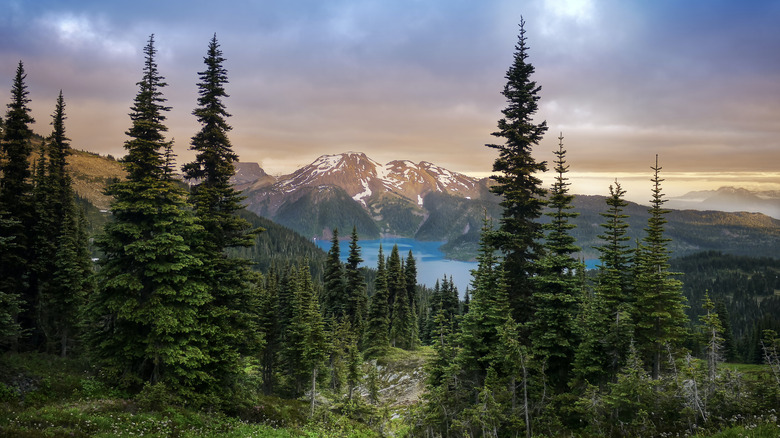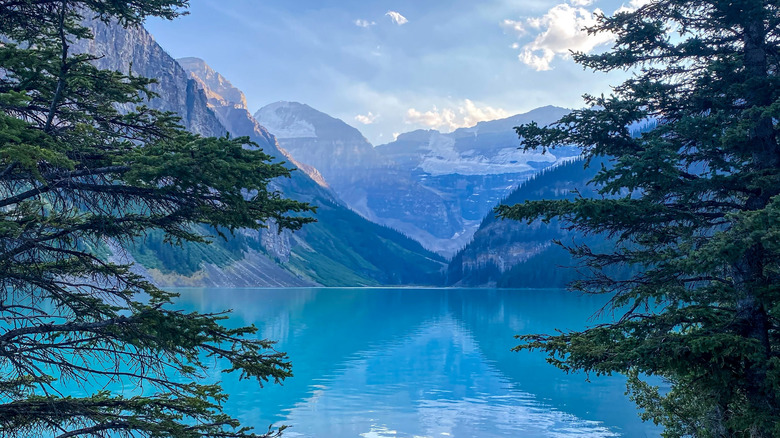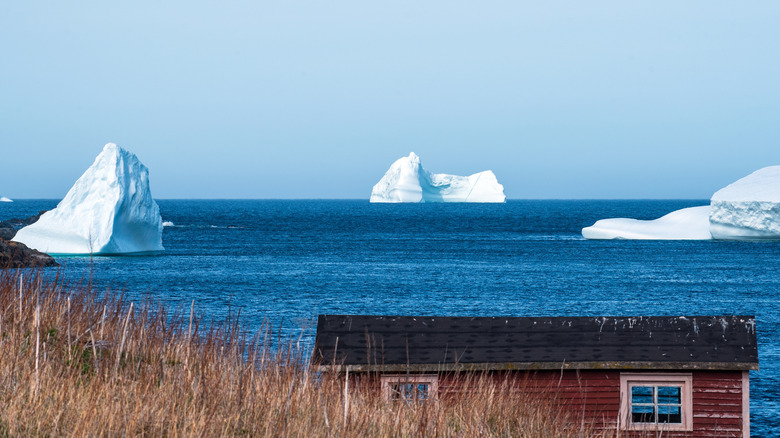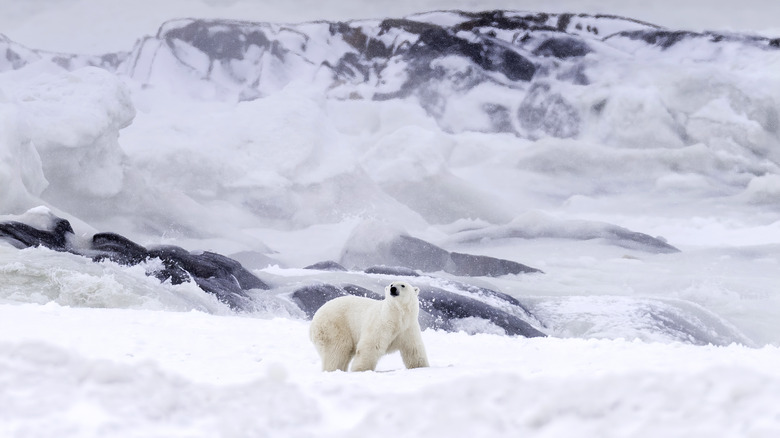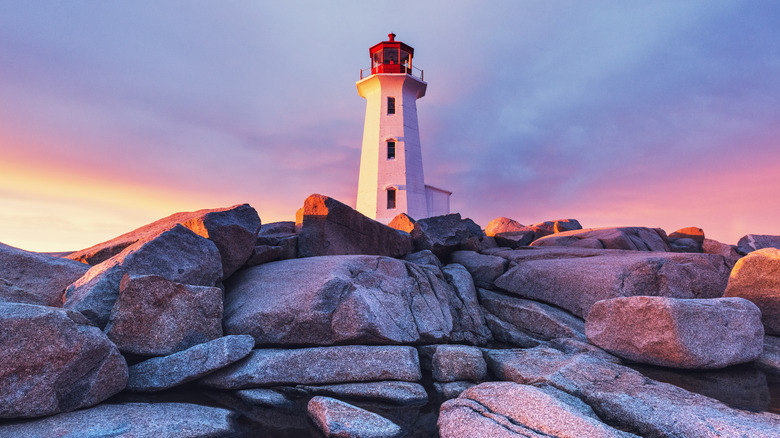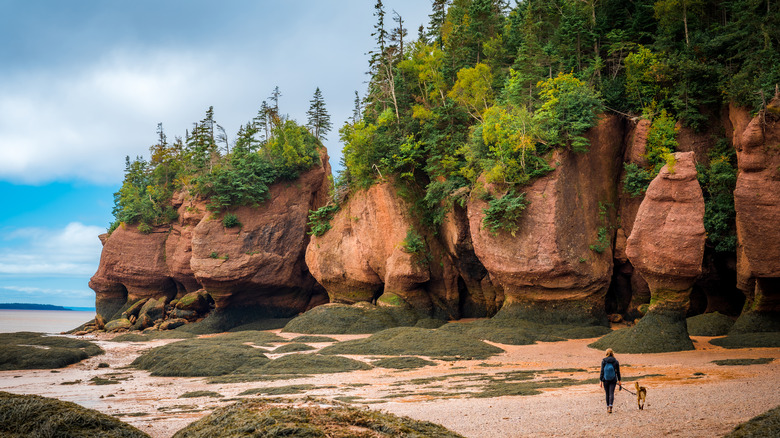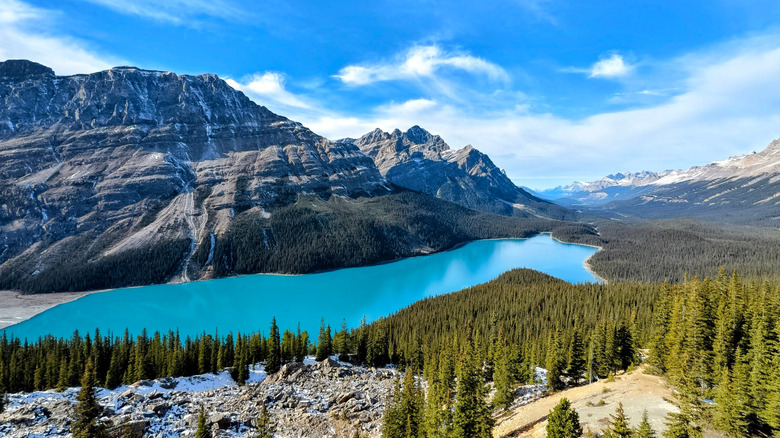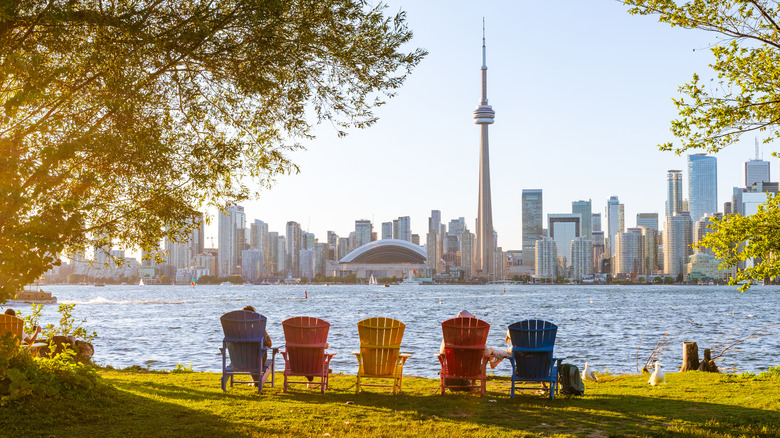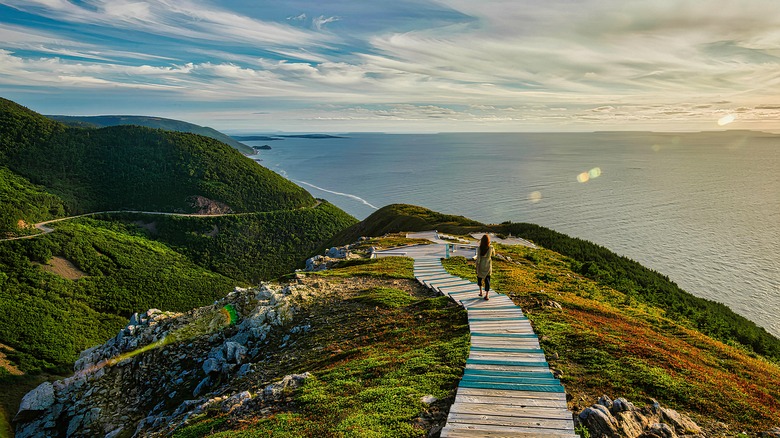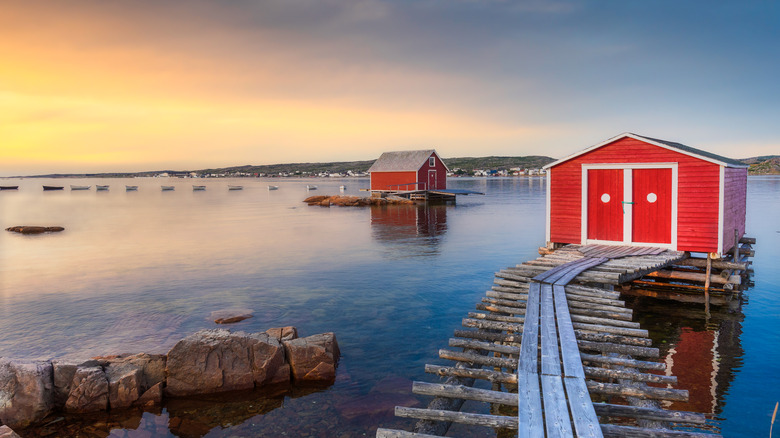Canada's 14 Best Destinations To Snap Beautiful Pictures
Canada is a country defined by scale and contrast, where vast forests meet ocean cliffs along the longest coastline in the world, and glacial lakes sit beneath snow-capped mountain peaks. For photographers, it offers extraordinary variety, but even in a landscape this rich, certain places stand out. These are the scenes that top the list when it comes to Canadian beauty — locations where light, water, and terrain come together in ways that look almost too stunning to be true. From the iceberg-lined coast of Newfoundland to the mirrored surface of Lake Louise, each setting reveals a distinct part of the country's story.
Some are famous, others tucked away, but all share a balance of accessibility and drama that keeps photographers returning. Many can be reached with little effort — a pull-off from a highway, a short trail from a nearby town — yet each delivers views that feel far removed from the everyday. Together, these locations form a cross-country snapshot of Canada's landscape — places shaped by weather, light, and season, where scenery does most of the talking. They capture both the quiet and the vast, the familiar and the remote — reminders of how easily the country turns an ordinary moment into something worth framing.
Lake Louise, Banff, Alberta
Famous for majestic mountains and vibrant blue waters, few places capture the drama of Banff National Park quite like Lake Louise. The lake's glacial waters shift from jade to turquoise as the light changes, creating a natural mirror for the surrounding peaks and the towering Victoria Glacier beyond. In summer, red canoes glide across its surface, their reflections slicing through the stillness, while winter transforms the scene into a frozen tableau of snow and ice.
The steep forested slopes that frame the lake add to its sense of enclosure, creating a tranquil pocket of alpine perfection. Nearby trails climb to higher vantage points where the valley unfolds in layers of green, grey and white. It's a landscape that feels both cinematic and serene — one that has become an emblem of Banff National Park itself. Whether seen at first light when mist drifts across the water, or under evening skies dusted with pink, Lake Louise is one of Canada's most instantly recognizable settings.
Twillingate, Newfoundland and Labrador
Set along the northeastern coast of Newfoundland, Twillingate is one of the best places in Canada to see icebergs drift close to shore. Each spring and summer, massive chunks of ancient ice break away from Greenland's glaciers and make their slow journey south through what's known as Iceberg Alley. And while Canada is home to North America's toughest hiking trail, you don't need to embark on a challenging trek to enjoy the best views. From the cliffs, you can watch icebergs glide past brightly painted fishing huts and small coves scattered along the rocky coastline. The town of Twillingate is compact and easy to navigate, with several viewpoints within walking distance of one another.
Local operators offer boat and kayak tours that get you close enough to hear the ice crack and shift as it melts into the sea. Visiting from late May to early June usually offers the most reliable sightings, though the weather can change quickly this far north. When the light softens in the evening, the 'bergs catch pink and gold tones, contrasting against the cobalt water. It's a rare glimpse of the North Atlantic's changing landscape and a chance to immerse yourself in the beauty of Newfoundland, also known for its European culture and experiences.
Chesterman Beach, Tofino, British Columbia
Stretching along Vancouver Island's rugged west coast, Chesterman Beach is as much about atmosphere as scenery. Here, the Pacific Ocean rolls in with restless energy, curling into white-tipped breaks that draw surfers from dawn until dusk. At low tide, the sand turns into a vast reflective canvas where the sky doubles itself in soft greys and silvers during the day, and blazing orange and yellows as the sun dips below the horizon. The beach's twin crescents are punctuated by tide pools, driftwood, and windswept pines. In winter, waves crash dramatically against the rocks, transforming the shoreline into a theater of spray and light — making it a popular season for storm watchers, despite the colder weather.
Despite its wildness, Chesterman is easily reached from Tofino, just a few minutes' drive or a leisurely cycle from town. It's well signposted, with roadside parking and direct access to both the North and South sections of the beach. The setting feels remote yet is accessible — close enough for a morning walk or an evening surf session, but far enough from town for wide, uninterrupted horizons. It's this balance that makes Chesterman a favorite stop for photographers exploring Vancouver Island's west coast.
Churchill, Manitoba
The only province in Canada where you can spot each of the country's "Big Five" wildlife, Manitoba is home to Churchill, known as the polar bear capital of the world. Each autumn, hundreds of bears migrate across the tundra toward the coast, waiting for the sea ice to form so they can begin their winter hunt — although bears can be found year-round, this is by far the best time to see them. This seasonal movement has made Churchill one of the few places on Earth where people can reliably see polar bears in the wild. The small town, reachable by plane or train from Winnipeg, serves as a hub for guided tours that use specially adapted tundra vehicles to navigate the icy landscape.
The surroundings are stark and striking, with flat stretches of snow and frozen water broken only by low willows and the occasional Arctic fox. The northern lights also often appear above the bay, adding another layer of spectacle. Despite its isolation, Churchill is well equipped for visitors, showcasing one of the world's most elusive animals in an environment that feels truly at the edge of the map.
Peggy's Point Lighthouse, Nova Scotia
Perched on smooth granite rocks above the Atlantic Ocean, Peggy's Point Lighthouse is one of Canada's most distinctive landmarks. The charming surrounding village of Peggy's Cove sits just under an hour's drive from Halifax, making it an easy day trip along a scenic coastal road. The landscape here feels stripped back to essentials: bare stone, salty air, and the constant sound of waves against rocks. Visitors can wander across the polished boulders to reach the lighthouse itself — the present structure dates back to 1915 and still marks the entrance to Saint Margaret's Bay.
Weather plays a big part in its character. Bright days show off the red-and-white tower against a blue horizon, while fog and drizzle give the area a quieter, more atmospheric tone. There are cafés and small craft shops nearby, but the setting remains largely untouched. Whether you stay for half an hour or half a day, Peggy's Cove is a striking reminder of Nova Scotia's maritime identity and delivers picture-perfect scenery every time.
Hopewell Rocks, New Brunswick
Rising from the shores of the Bay of Fundy, the Hopewell Rocks are among Canada's most famous coastal formations. Sculpted over thousands of years by the world's highest tides, these sandstone towers — often called "flowerpots" for the trees growing on top — reveal their full height only when the tide recedes. The site is easy to reach by road from Moncton, with an interpretive center and well-maintained trails leading to several lookout points and a long stretch of accessible beach. At low tide, you can walk directly among the formations, their bases darkened by the retreating sea.
When the tide returns, the same rocks appear as isolated islands surrounded by swirling water, and are best explored by kayak. The constant rise and fall, roughly every six hours, transforms the view throughout the day. Many visitors time their trip to see both extremes, combining a beach walk with an elevated perspective from the cliffs above. It's an excursion that showcases nature in its extremes, in one of the most unique places in not just Canada, but also the world.
Emerald Lake, Yoho National Park, British Columbia
Located just a short detour from the Trans-Canada Highway near Field, British Columbia, Emerald Lake is surrounded by steep, forested slopes and rugged peaks that seem to rise straight from the water's edge. The lake's vivid color, a surreal shade of green, comes from fine glacial silt suspended in the water, which reflects light differently as the day goes on. A flat 3.2-mile loop trail circles the shoreline, offering views from every angle, while the small wooden lodge at one end provides a striking focal point for photographs.
Early summer brings snowmelt streams cascading down the surrounding ridges, while autumn transforms the area into a palette of deep greens and ochres. Despite its popularity, Emerald Lake still feels like a very calm place to visit, especially in the morning before the day-trippers and coach buses arrive. It's a memorable stop that captures the character of the Canadian Rocky Mountains in a single scene — perfect for show-stopping photos at any time of day.
Peyto Lake, Icefields Parkway, Alberta
Located high along the Icefields Parkway between Banff and Jasper, Peyto Lake is undoubtedly one of the most stunning views in the Rockies. A short walk from the upper parking lot leads to a viewing platform overlooking the lake shaped uncannily like a wolf's head. From there, a gentle loop trail continues through the surrounding forest, offering more views and a quiet stretch among the trees.
The color of the water changes with the seasons as meltwater carries fine rock particles down from the surrounding peaks. Even on overcast days, the hue stands out vibrantly against the dark spruce forest that blankets the valley below. In early summer, snow still lingers along the edges, and the air feels cool and crisp at this elevation. As the sun moves across the valley, the light picks out shifting textures on the lake's surface and surrounding ridges. It's a place that captures the scale and beauty of the Icefields Parkway in a single frame, perfectly composed by nature.
Montmorency Falls, Quebec
Just a short drive from Quebec City, Montmorency Falls delivers the kind of drama usually found much farther from an urban center. The waterfall drops 272 feet — roughly 100 feet higher than Niagara Falls — creating a constant cloud of mist that hangs over the surrounding cliffs. In summer, visitors can walk the suspension bridge that stretches across the crest for an aerial view of the torrent below. A cable car also runs between the river level and the clifftop, offering another vantage point of the plunge pool and its rainbow spray.
The site is fairly easy to navigate, with wooden stairways leading to several lookouts that reveal the falls from different angles. Winter, meanwhile, brings an entirely different atmosphere as the water freezes into sculptural ice formations, including a towering cone that forms at the base. Whether in full flow or frozen solid, Montmorency's power and accessibility make it one of Eastern Canada's most photogenic natural landmarks, and a reminder that wild scenery isn't confined to the country's remote corners.
Western Brook Pond, Gros Morne National Park, Newfoundland
Western Brook Pond sits within the dramatic landscape of Gros Morne National Park, where steep cliffs rise above a long, narrow lake. Once a fjord connected to the sea, it was cut off by glacial retreat thousands of years ago, leaving behind a freshwater basin surrounded by sheer rock walls. The setting feels like something almost otherworldly, but is actually surprisingly reachable, with a boardwalk trail leading across coastal bogland to the boat dock at the lake's edge.
From here, tours take visitors deep between the cliffs, where waterfalls plunge from the heights and the water reflects every detail of the stone above. The surface is often so still that it mirrors the cliffs perfectly, creating a sense of depth that's difficult to capture in a single photograph. Early mornings bring mist and silence; later in the day, sunlight filters through narrow openings in the rock. Western Brook Pond is one of those rare places where scale and solitude combine, leaving a lasting impression long after the journey ends.
Aurora, Northwest Territories
The Northwest Territories offer some of the most reliable and vivid aurora — or northern lights — displays in the world, particularly around Yellowknife, where clear winter skies and low light pollution create ideal viewing conditions. In fact, the natural light show can be seen up to 240 nights per year. From late August to April, ribbons of green and purple light frequently sweep across the horizon, shifting and folding with each burst of solar activity. The region's open tundra and frozen lakes provide wide, uninterrupted views of the sky, and the reflective snow often doubles the effect.
Many visitors stay at small lodges or homesteads just outside of the city, where heated cabins and traditional-style teepees add authenticity and character to the setting. On calm nights, the silence is broken only by the creak of the snow underfoot or the faint hum of the wind. The aurora remains unpredictable, but never disappointing. It's one of those natural spectacles that feels different each time you see it. For photographers and travelers alike, it's an unforgettable experience.
Toronto Islands, Ontario
Canada is full of stunning island getaways, but not all require extensive travel to reach — in fact, some of its best islands are also the most accessible. A short ferry ride from downtown Toronto leads to the Toronto Islands, a chain of small, car-free islands that offer the city's best skyline views. From spots like Ward's Island or Hanlan's Point, views of the CN Tower and high-rises appear across the harbor, their reflections visible in the calm water during sunrise and blue hour. The islands are peaceful, with tree-lined paths, beaches, and residential cottages that feel a world away from the bustle of the mainland. While Toronto itself may seem like a concrete jungle, it's home to a secret network of thriving wilderness — sprawling ravines, parkland, and forested trails that span from the lake to the northern reaches of the city.
Cyclists and walkers share the paved trails that link each section of the islands, and there are plenty of open spaces to pause and take in the contrast between skyline and shoreline. In summer, the area has a relaxed, almost nostalgic feel, with children playing on the beaches and sailboats drifting past. In winter, the same view turns crisp and quiet. It's a rare urban location where a short journey delivers a completely different perspective, framing Canada's largest city against its own reflection.
Cabot Trail's Skyline Trail, Nova Scotia
The Skyline Trail sits high above the Gulf of St. Lawrence on Cape Breton Island, offering one of Atlantic Canada's most memorable coastal views. The trail itself is part of the famous Cabot Trail drive, winding through Cape Breton Highlands National Park before ending at a broad wooden boardwalk that follows the headland to the edge of the cliffs. From here, the view stretches across rolling hills and sheer drop-offs to the ocean far below, with the Cabot Trail road visible in sweeping curves along the coastline.
On clear days, the horizon feels endless; in autumn, the surrounding forest erupts in shades of red, orange, and gold. The trail is well marked and relatively gentle, attracting a mix of walkers, photographers, and wildlife watchers — moose sightings are common in the early mornings, a major draw among visitors. Whether seen under summer light or through the haze of an Atlantic sunset, the Skyline Trail captures the wild openness that defines Nova Scotia's northern coast.
Fogo Island, Newfoundland
Fogo Island sits off the northeastern coast of Newfoundland, a place where traditional fishing communities and modern design coexist against a backdrop of open sea. The island is reached by ferry from Farewell on the mainland, and its scattered settlements still follow the contours of sheltered coves and rocky inlets. Wooden stages and saltbox houses line the shore, reminders of centuries-old outport life. In recent years, Fogo has become known for its bold, minimalist architecture — particularly the Fogo Island Inn, which rises on stilts above the rocks — but the island's appeal remains rooted in its rugged setting.
Icebergs drift past in spring, seabirds wheel overhead, and the North Atlantic stretches uninterrupted along the horizon. The quiet roads and coastal trails encourage slow exploration, revealing new perspectives around every headland. Remote yet welcoming, Fogo Island captures what some would say is the essence of Newfoundland: a meeting of history, landscape, and art at the edge of the ocean.
Methodology
This collection highlights specific places across Canada chosen for their visual impact, accessibility, and striking photo opportunities. Each spot represents a distinct landscape — from glacial lakes and coastal headlands, to urban skylines and Arctic tundra, these places consistently draw photographers and travelers alike.
Selections were based on photography-related research, local tourism data, and my personal experiences from living in Canada for nine years. The focus is on precise locations rather than broad regions, spotlighting the viewpoints, beaches, and villages that best express the country's natural diversity. Together, they form a snapshot of Canada's vast geography through the lens of its most photogenic moments — places where the light, landscape, and atmosphere come together to define what makes the country so compelling to capture.
